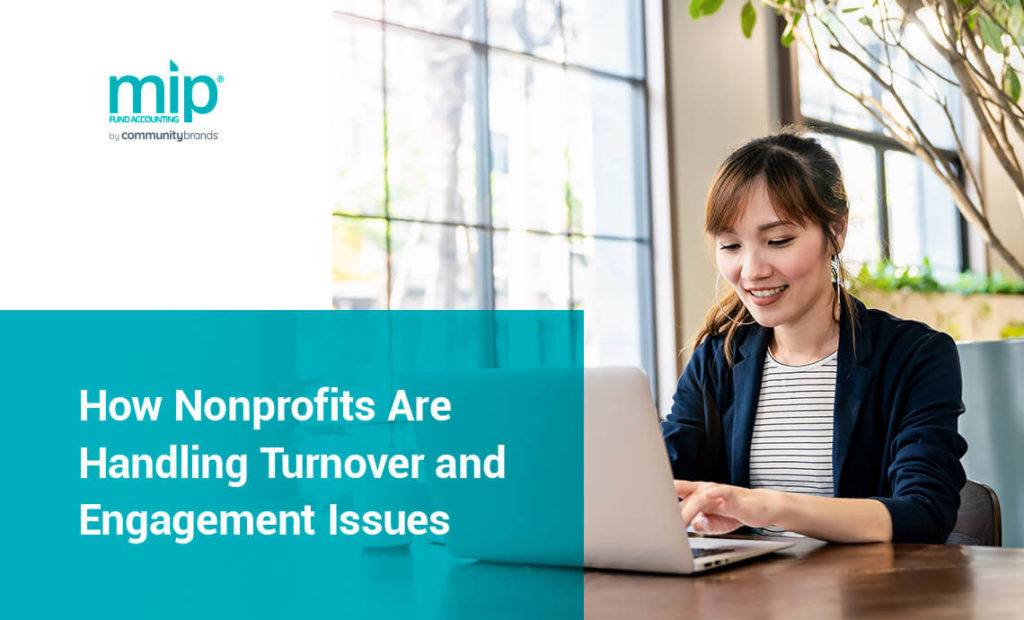Nonprofit Accounting, Nonprofit Management
How Nonprofits Are Handling Turnover and Engagement Issues

Today, employee turnover in nonprofit organizations is a growing problem. The Great Resignation hit the nonprofit sector hard during the pandemic. However, organizations were already facing difficulty retaining employees because of low pay and long hours. Though many people choose to work in the sector to help people and make an impact, this hasn’t stopped them from quitting.
Along with employee turnover, nonprofit organizations are also experiencing employee engagement issues. At the start of the pandemic, employee engagement was one of the greatest challenges nonprofits were facing. Though many organizations have made improvements and adapted, most have not returned to pre-pandemic levels. Employees are growing increasingly dissatisfied with pay and working conditions in all sectors, so it’s essential to understand how to engage employees and how to retain them.
Why Nonprofits Struggle With Employee Retention
Employees typically don’t join nonprofit organizations for the money. Instead, they enter the sector to positively impact their community. Many hope to make a difference in the lives of others, and their work is fulfilling when they’re successful. However, fulfillment and motivation aren’t always enough to prevent an employee from leaving an organization.
The pay tends to be low among nonprofits. Depending on the organization, the hours may also be long. High employee turnover in the nonprofit sector has been rampant in the industry for years and only seems to be getting worse. This problem is worse among organizations located in vulnerable areas. Even when employees feel motivated to help people and like they have a purpose, few feel equipped to stay in the nonprofit sector long term when they’re overworked and underpaid.
Nonprofit employees may also quit for any of the following reasons:
- Lack of promotions: Few leadership positions in nonprofit organizations get filled internally. Passing over employees for promotions could reduce their loyalty to the organization.
- Excessive workload: Excessive workloads often lead to burnout, and employees who constantly feel overwhelmed at work may seek different career opportunities.
- No career development: Professional development helps employees grow in their careers and ensures them of the nonprofit’s investment in their success. When there is no professional or career development, employees may go to another organization that shows an investment in their career.
- Inflexible work schedule: Flexible work schedules help employees maintain a healthy work-life balance and avoid burnout and stress. If work schedules are inflexible, employees may be more at risk for burnout and choose to leave the organization.
- Lack of upward mobility: One of the major reasons employees leave nonprofits is the lack of upward mobility. Many employees want to work in an organization that offers opportunities for advancement and progress. When an organization doesn’t offer opportunities for upward mobility, these employees may not want to stay.
- No recognition or rewards: People want to feel appreciated in the workplace and to have their hard work acknowledged. When employees receive recognition or rewards, they’re more motivated to continue doing good work. Without any acknowledgment, employees may want to find another work environment where the company values their effort.
- Lack of a mentoring program: Without a mentoring program, a nonprofit organization could experience a dramatic drop in productivity and the loss of institutional knowledge passed from one generation of employees to the next.
Additionally, millennials make up a large portion of the current workforce. They are less loyal to the organizations they work for than previous generations, which means organizations need to adapt to the new generation of workers and develop strategies to attract and retain employees.
Negative Impacts of High Nonprofit Turnover
High turnover rates in the nonprofit sector can have negative impacts on organizations. Leaders must frequently recruit, interview, and train new hires, which is a time-consuming process and can detract from the organization’s vision and mission. Retaining employees allows organizations to benefit from a high-caliber team that positively impacts the bottom line. Some of the negative impacts of high nonprofit turnover include:
- Poor morale: When turnover is high, your nonprofit organization could face low employee morale. Remaining employees could become overworked if they have to temporarily take on the workload of a former employee. Even new employees may experience low morale as they acclimate and struggle to learn new procedures and duties. If poor morale continues, your organization could have difficulty attracting and retaining high-quality talent.
- Loss of funds: High turnover has a negative impact on your organization’s funds. Factors that contribute to this loss of funds include costs related to hiring, training, and lost productivity. Depending on the employee’s position, the impact on funds could be even greater. You could also lose funds to manage labor costs, classified ads, and time spent reviewing applications, interviewing candidates, and training new hires.
- Deterioration of service quality: Many new employees or a low number of experienced employees could lead to lower quality of work and productivity. Those who rely on your organization’s services might feel the impact of this change in service quality. Worse, with high employee turnover, you may not be able to provide the mental, social, or financial support your community needs.

How to Keep Employees Engaged
Fortunately, you can implement employee retention strategies to keep employees engaged and encourage them to stay with the organization.
- Pay employees fairly: One of the top reasons employees leave a nonprofit organization is low pay. To combat this, invest in your employees by compensating them fairly. Restrictions on government funding, grants, and donations can make offering competitive compensation more challenging for nonprofits. The key is communicating the need for fair employee compensation to your stakeholders and calculating the cost of fair compensation versus the cost of turnover.
- Recognize employees’ work: To demonstrate that you value each employee’s contribution to your organization, recognize and acknowledge your employees and their hard work.
- Prioritize work-life balance: Your employees will be happier and work harder with a healthy work-life balance. When you demonstrate that you care about your employees, they’ll reciprocate by going the extra mile at work.

Request a Demo of MIP Fund Accounting®
At MIP®, we created our nonprofit fund accounting software to help nonprofits better serve their communities. With our software, you can automate your fund accounting, which is essential for closely managing your funds and expenditures to keep your operations successful. We can increase your nonprofit’s efficiency, support your financial needs, and ensure your data is accessible and secure.
With our robust reporting suite, you can report funds how you want, track unlimited funds, and distinguish between your fund sources. MIP Fund Accounting® scales with your nonprofit as your organization grows. To learn more about what our software can do for your nonprofit, request a demo of MIP Fund Accounting® today.
Share this post




